Home Movie Facts Fans+Reviews Where to Watch News+Blog Store

I asked my mother for advice on how to cope with the grief of losing her. Her well-meaning answer left me unsatisfied at the time.
"I'll be all around you!" She replied. With an air of confidence, she swept her hand around to indicate the meadow beyond. "I'll be in the flowers and the fields!"
I digested this without comment, and before long, came to a sour conclusion. It’s the old bait and switch! I don't want trilliums and lady slippers, damnit. I WANT MY MOM.

Kim Waters's art, which triggered a turnaround in my thinking
It has taken around three years for her disappointing answer to gestate. Lately it has taken on new meaning which does, to my surprise, comfort me. I want to share this new meaning. This new meaning was triggered by a comment from my friend Kim Waters. She was describing the themes of her devotional artwork. Something she had said formed a seed that sort of lodged in my mind. It sprouted, three years later, into a new way to look at my mom’s advice. That new meaning is the topic of this article. Aspects of my mother do live on, in fact, in different forms around me, and in me.
This new idea does not make all my pain go away like magic. It reduces the pain by various degrees, off and on.
A brief timeline to today: The conversation I had with my mom about how to cope with my losing her was in May of 2014. Following that conversation, her memory declined faster than we had anticipated. I became her medical and legal power of attorney, controlling everything from her bank accounts to insurance to doctor's appointments and long distance hiring of care giving and more. By the summer of 2015, we placed her into assisted living, which she resisted angrily at first, but later embraced. At the time of this writing (Dec 2017) she was just moved into skilled nursing care, and that is requiring even more adjustment. So far, so good.
I will never forget her visit in May 2014. Planning her solo flight from her Rocky Mountain Colorado home to my own in rural Wisconsin stressed me out. She acknowledged her tendency to get lost in strange surroundings, and thus readily accepted my request for a wheelchair escort. If you are wondering how to get someone with cognitive problems from point A to B by plane, weigh the pros and cons of this fabulous and free service that most airlines offer. She didn’t need a wheelchair, but the escort helps keep a passenger from getting lost when changing gates. In theory. It probably isn’t fail proof, and at this stage I would definitely not use this service for my mother. She needs too much continuous watching by a trained caregiver. Like sending a baby to fly off alone; too risky. But for transporting someone in early stages of cognitive decline, a wheelchair escort can put your mind at ease.
Worrying about her making her plane connections made me sick, literally. The power of my own nervous system astonished me on the morning
of her flight. How well could I trust the wheelchair service? Would she make three plane connections to what I like call our Apple Strudel Airport
in Green Bay, a two-hour drive south of where we live? (Actually Austin Straubel. Apple Strudel just sounds more delicious.)
My stomach roiled with sudden queasiness after I finished my morning oatmeal. Alarmed, I ran into my husband’s home office. I managed to blurt, “Tim, I am not feeling so good…” just before I vomited up my entire breakfast, in a flash, before him. “I must be really worried!” I said, rattled by the suddenness of my attack.
Despite her seeming mostly normal during her stay at our house, I had this sick, looming sense of dread that this would be the last time, ever, that she would be able to see me in my home.
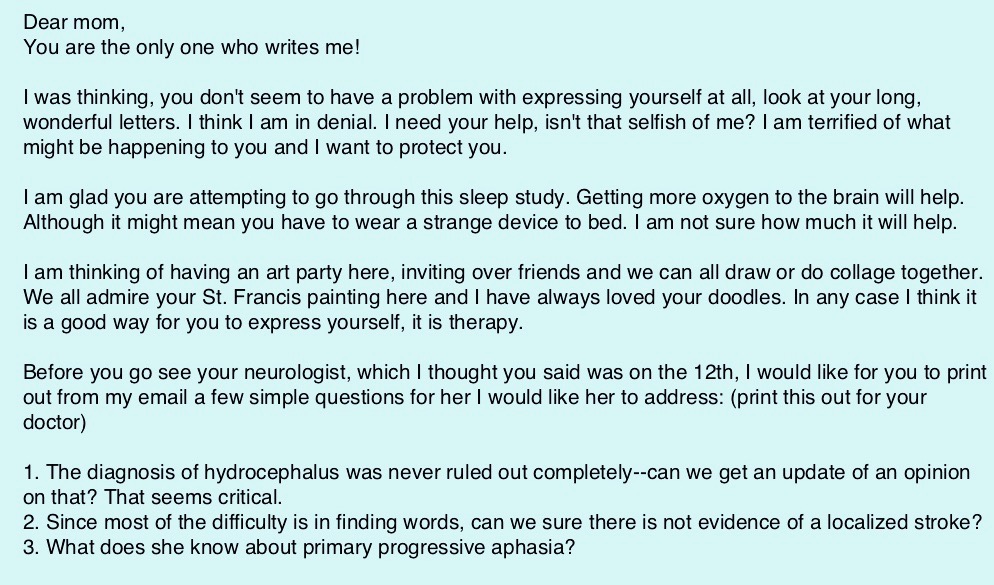
A letter emailed to my mom prior to her visit. We emailed each other almost every day for years.
There were signs during the visit.
Convinced a certain outdoor light had to be left on outside her bedroom, she kept it on, even though I had told her there was no reason for it to be
on. She complained that the light had interfered with her sleep for most of the visit. All she had to do was turn it off.
She asked me for a lesson in using her cellphone. No matter how many times I told her that her old style flip phone window was not responsive to touch, she kept trying to press the window. Don’t touch that window, it doesn’t do anything, I would say. And then she would press it immediately after I said this. Over and over. I had written down instructions repeatedly for her to use her phone.
I have years of teaching college chemistry and I pride myself to think I’ve developed special skills on the gentle coaching of frightened students. I remember consciously trying to make use of these particular skills. This backfired. No matter how patiently I tried describing what to do, she’d get touchy, insisting I was condescending. “You are treating me like a child!” She would start crying. It was easier for me to give up. It really stings when you think you’re some great teacher and your own mother completely rejects your coaching.
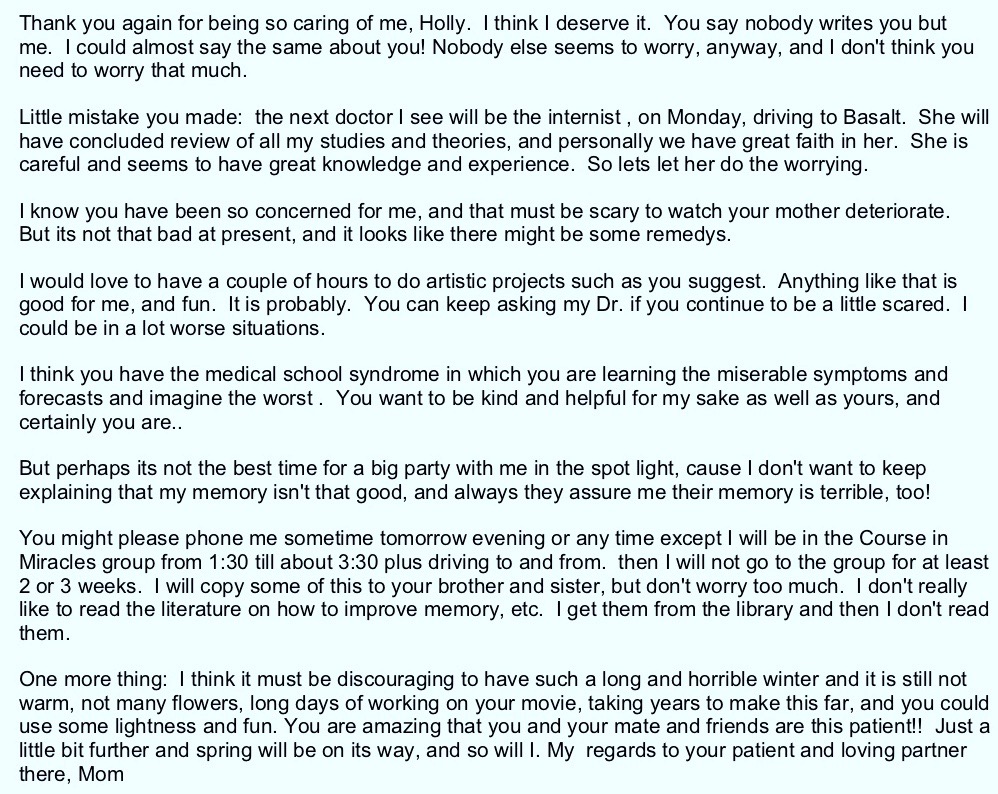
My mom's emailed response to me, telling me not to worry too much about her
It was only the second time she had seen our house, and I wanted to introduce her to my friends and community. She knew we had been making The Emissary movie, and held this stubborn misconception that everyone in our neighborhood knew about this and were even participating! She liked the idea, and kept repeating that “everyone in our town” was helping to make our movie! I would tell her, no, that isn’t really true at all. But she didn’t compute this.
She loved to go for walks. (She still walks daily thank goodness, thanks to escorts from her nursing home.) She got lost repeatedly in walks around my
neighborhood. Not able to find her way home, she would flag a neighbor, and ask for instructions to get to the home of the people making the movie!
Of course, no one knew what she was talking about. Fortunately I had thought ahead to put in her purse a piece of paper with our home phone number
on it. We’d get phone calls from confused people saying they had picked up a lost woman who was trying to find the movie makers’ house.
I was never able to convince her that her fantasy of our entire community happily participating to create our movie was completely false. She went on to
tell anyone she met this story, and I just had to let it go.
Therapeutic fibbing sometimes becomes a useful tool, in late- stage dementia. I have no problems with the ethics of this as long as it keeps her
happy and doesn't hurt anyone. She insists that her ex-husband's house was her parents' house, for example, and it was not. I just say, "Isn't that
interesting?" in response.
You know how you want your family to have a relatively precise sense of where you live and what your daily life is like? There is only so much you can do in this regard. Eventually, you have to let that desire go. It’s a relief to let it go, really.
My mom’s visit here was during my favorite time of year. Springtime in Door County! May is early enough so that the tourists are thin on the ground, with wild flowers are making tentative appearances. Peace, quiet, and beauty all at once; a rare occasion.
I wanted to show her our famous lady’s slipper orchids, but they had not quite bloomed. When you look at a cluster of lady slipper flowers, you are looking at decades of slow growth. It can take years for one lady slipper flower to appear, and a cluster of lady slippers might be several generations old. That’s why it’s a crime to pick them. We went out for a walk on one of our beautiful countryside roads and I tried unsuccessfully to hunt down one lady’s slipper orchid for her. Lilacs, cherry trees, and apple trees bloomed. White trilliums carpeted the woods in that way that always causes me to imagine some rogue elf toilet papered the forest floor as a form of mischievous protest.
It was a hard question to ask but I was running out of time. Her ability to talk was failing. Her ability to come up with the right word had always been terrible, once a source of humor in our family. But her aphasia had become serious. Her speech was full of painful pauses and stuttering. She was constantly floundering with trouble finding the right word. “Just make up a word!” I encouraged her. That is a valid technique—substituting a nonsense word—and actually works for some aphasics, but she couldn’t manage it. I had no idea how long she would be able to sustain a conversation.
How do we communicate going forward? I had been lying awake at night, brainstorming alternative methods of communication: would written notes, art, singing, or sign language work better over time? In that regard I eventually found a certified art therapist for her. Kym Allison provided fantastic therapy for the few years that my mom could manage to create art. She passed through an incredibly productive art phase and her therapeutic paintings will remain deeply meaningful to our family. At this stage, however, she can only blob out abstract blotches of paint. I’ve become close to the therapist, who probably understands my mother better than most people. In a serendipitous twist, I found the therapist and my mom might be distantly related!
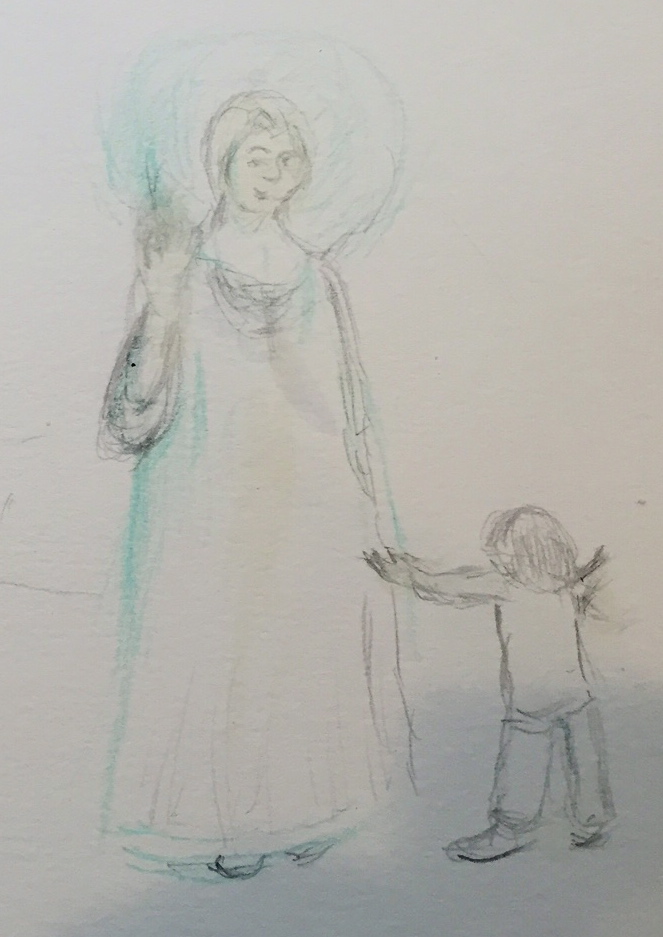
Some of my mom's early art therapy work
Mom kept claiming she was talking more easily during her visit. She theorized that it was therapeutic for her to be in the quiet countryside. “I don’t know…what is wrong…with my talking!” she told my friends apologetically. “But I am much better than I was! I think…it's something…about being here!”
Door County is incredibly quiet, and my sense is that this peacefulness causes your nervous system to power down in a way that probably has health benefits we don’t know how to quantify yet. My mom’s home tourist town of Glenwood Springs, by comparison, has a major interstate highway running right through the center of downtown, a constant stressful noise. Whatever minor improvement she felt she experienced during her visit didn’t last.
I can still picture the exact curve of road on our street where we had this conversation. I was not able to ask her without crying.
"I need some help. How would you recommend I deal with your death? After you are gone?"
She paused along the way, looking out over at the apple orchard as if to collect her thoughts. Then she quoted a rather sentimental old poem.
"I am aware, I am aware, that you are there, as I go commonly sweeping the stair..."
This was a rather dramatic old poem that her parents liked to recite (Kinship, Angela Morgan).
They taught college literature and loved to quote poetry at each other. Her memory had altered her parent’s words. But she was trying to express that
when I am doing mundane, everyday things like cleaning, I should remember she and, indeed, the most powerful forces of the universe, are thundering
quietly all about me. That is the gist of the poem, which I dug up years later. It’s a good one.
Her comment altered how I sweep my stairs. With four cats continually generating a hair-based precipitation this is a daily chore. I’ve turned it into a ritual. I’m always reminded of her attempted recitation of this poem. I ad lib a song while I sweep, which usually starts out like this:
As I clean my stairs right here
(Then something positive that rhymes that comes to my mind, like:)
Answers will become all clear!
or,
Health and happiness will be near!
It doesn’t have to rhyme, but it’s at the very least a fun challenge to quickly come up with something that rhymes. Sure, my Stair Sweeping Songs are silly, but it beats cleaning in stoic silence. I enjoy the practice. You might as well make up a new song every time you sweep. It’s a waste not to.
Then, following her attempted poem recollection, she gave me the disappointing answer that she would be “all around me” and that I would
know this. “I’ll find a way to reach out to you,” she said impishly. I stayed quiet. I have decades of experience that taught me not to debate her
on these topics.
She always had a fascination for spiritualism and Messages From the Beyond. I’ve always adored her childlike sense of wonder with regard to things of a
mystical nature, and would never want to take that from her, but my own personal comfort comes from the predictability of science. I might disagree
with her, and she with me, but we always had a sort of comfortable Venn diagram overlap region where we could talk about things if I was careful where
I stepped. The dichotomy in what gives us comfort—her the mystical, and me the scientific method—is something that mom and I had generally
always tolerated comfortably (and I’ve written about this in Giving Up Epiphanies for Everyday Workouts.)
If she can reach out, hey. I am all for that. It's not something I am going to pin my hopes on, though.
I know atoms last billions of years, but the patterns they take, according to the second law of thermodynamics, degrade and dissipate into randomness. They lose information. It takes energy to sustain a particular pattern, and patterns are constantly changing. I didn’t voice my cynicism over her idea that she would be all around me. I didn’t want her to feel bad. She believed it, that was more important than me believing it.
Singing a song that I didn’t believe
She was voicing the same idea behind a well-known poem that my husband and I put to music, about nine years before our walk and talk about my losing
her. She might have even mentioned the song, I don't remember, during that walk.
In my more jaded moods I call this song The Grave-Weeping Song. The official title is In Every Lovely Thing.
I admit the time that I was recorded singing this, I suffered the same sense of quiet dismay. It’s supposed to be comforting. I was anything but comforted.
Here’s the first verse:
In Every Lovely Thing
Do not stand at my grave and weep
I am not there – I do not sleep
I am a thousand winds that blow
I am diamond glints on snow
I am sunlight on the grain
I am gentle April rain
Do not stand at my grave and cry
I am not there – I did not die
To hear me sing In Every Lovely Thing, click here.
music and additional verse by Tim Erskine,
from an original poem attributed to Mary E. Frye
Was I a hypocrite to sing words that I didn’t believe? I believed in the intention of the song. And I do believe the remarkable fact, for which there is ample proof, that we all trade each other’s atoms. Our atoms were formed inside one or two ancient stars that existed before our planet formed. (I wrote a couple blog posts on that wondrous fact (atomic meditation 1, atomic meditation 2).) Trading atoms is not the same thing as having an individual live on, though! I wanted the song to be comforting, and was gratified to hear that it was comforting from friends we had shared it with who had lost loved ones. But honestly, the words didn’t comfort me.
During her visit, I asked local artist Ram Rojas to come over to our house and give a Mandala making workshop. These workshops are one of his specialties. Friends of ours joined us, and we had a merry time drawing together in our living room, trying to capture in artwork some colorful image of what it looked like in our souls at the time. This requires introspection and imagination. I have kept my mom’s mandalas.
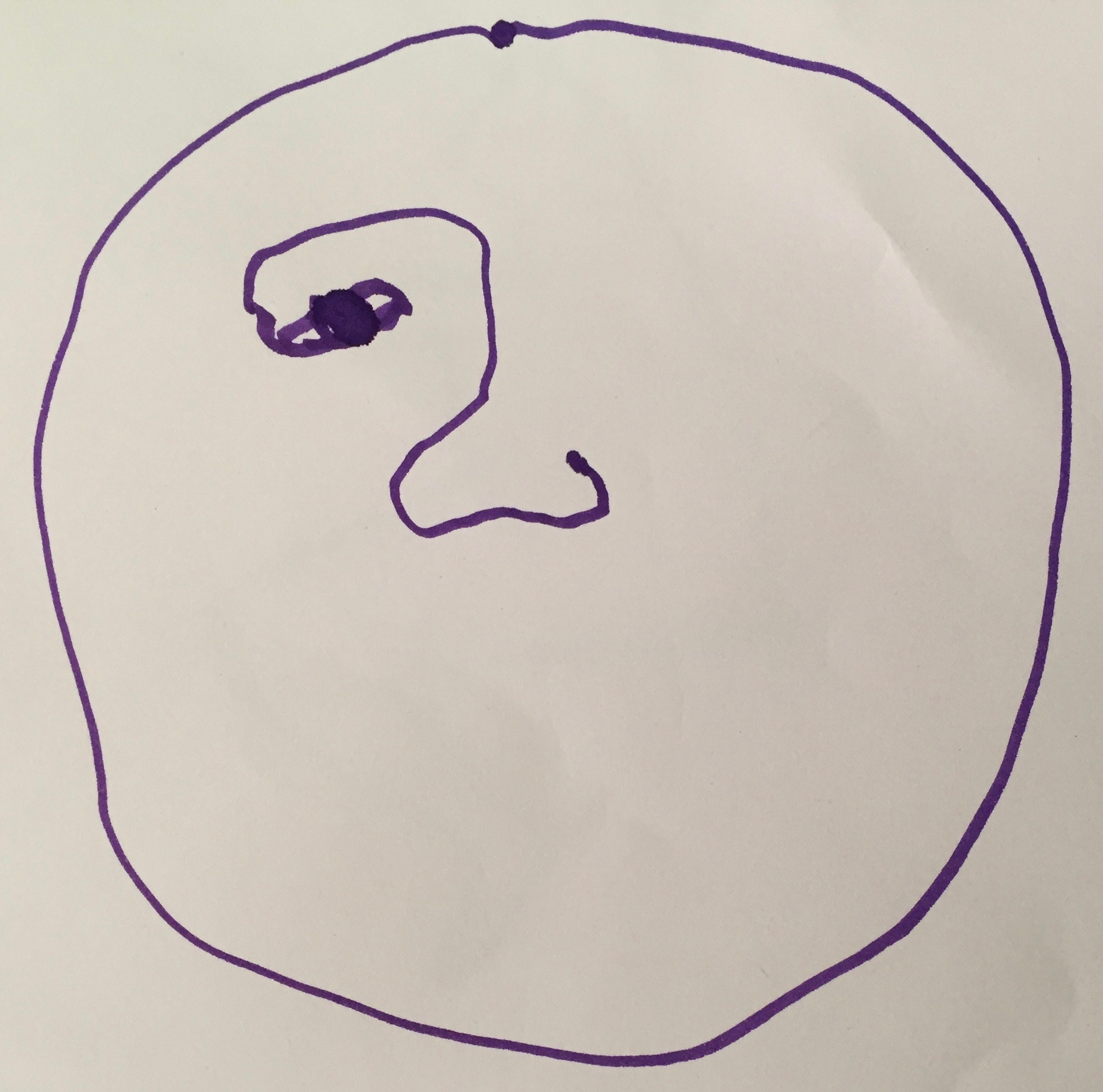
One of my mom's mandalas.I thought it significant that it was missing a mouth.
At the end of her visit, I escorted her to the airport so she could fly to her home. I saw her get wheeled off in the unnecessary wheelchair by a reassuringly kind-faced airline employee. “Wheee!” my mom laughed, tossing her white-blonde hair as if it was the best ride ever. I watched her rise up in the glass-enclosed airport elevator. The image of her rising up and up and up in the elevator to finally disappear is seared in my mind. The thought hit me like a shock. This is the last time I will ever see her in my home state, I thought, as I watched her rising like some strange, wheelchair-bound angel to the second floor of the Austin Straubel airport. I knew it.
That departure day was a hard day for several reasons. I had seen my mom off alone because Tim had to take our oldest cat to the vet for
a chronically sore leg. It was on my solo drive home that I answered Tim's call. He told me the news we dreaded most. Our cat’s sore leg was not a
simple strain. It was malignant vaccine-associated sarcoma. This is a rapidly invasive cancer. We had a choice. Either we amputate our cat's leg—which
would likely not keep metastases at bay—or we just help her have a good rest-of-her now shortened life of 18 years. We chose not to amputate
her leg. (We were able to enjoy six more months with her before euthanization was needed to relieve her ever-increasing pain.) I cried all the way
home from the airport, contemplating a second grief to prepare my mind for.
Tim had had a strange dream the night before I released my mom to the Green Bay airport. It was about one of our cats, not the one with cancer, but our youngest and most frightened one, Cupcake. In his dream she was sitting downstairs on the main floor of our house, in a particular position, which was odd, since Cupcake never ever went downstairs to the main floor of our house. She was too frightened to go down our stairs to the main floor of our house. Most of her life was spent upstairs in my office. We joked that it was her safety zone.
That day, following his dream, he woke and found Cupcake sitting in the very spot in his dream, downstairs, before she ran upstairs to the safety zone territory. He then looked up to see a bald eagle sitting in a tree branch right next to one of our windows, also something that never happens.
He told me all this when I got home from the airport, and I could tell that he was obviously quite spooked by the coincidence of his dream. Tim and I are
not superstitious people! We are scientists! But that day it all felt very heavy and portentous and symbolic for us both. My scientific self argues
that if you dream enough, you will find coincidences, statistically speaking. My wishful thinker self says I’ll just have to reserve the right for
room to hope for more. I'll just keep the mother-daughter Venn diagram overlap of science and symbol comfortably seated in my consciousness. They coexist.
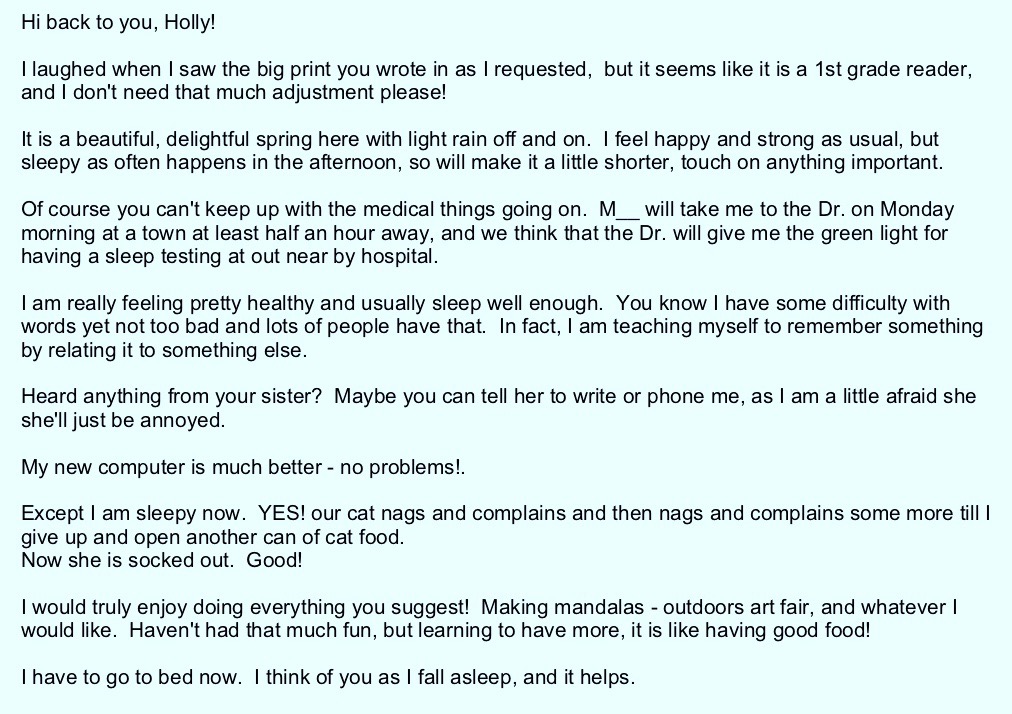
Another email from my mom, trying to reassure me
What I think of as the fix it fix it fix it phase ended a few months after her visit to see me. During her visit, I still had some hope that some therapy, medication, supplement, CPAP device, something, might help reverse or stabilize her condition.
That summer I had harbored hope that she had a treatable form of dementia called normal pressure hydrocephalus, or NPH. But the winter following her visit we had devastating news rejecting this idea. A three-day hospital stay confirmed she did not have NPH, ironically, right on her birthday, in November of 2014. (Happy Birthday! Your dementia is irreversible and will likely kill you!) That was a very hard month for me. I joined more social organizations in my community with the understanding that I, the shy introvert who always had anxiety socializing, would need support and friends. It has helped. I recommend it.
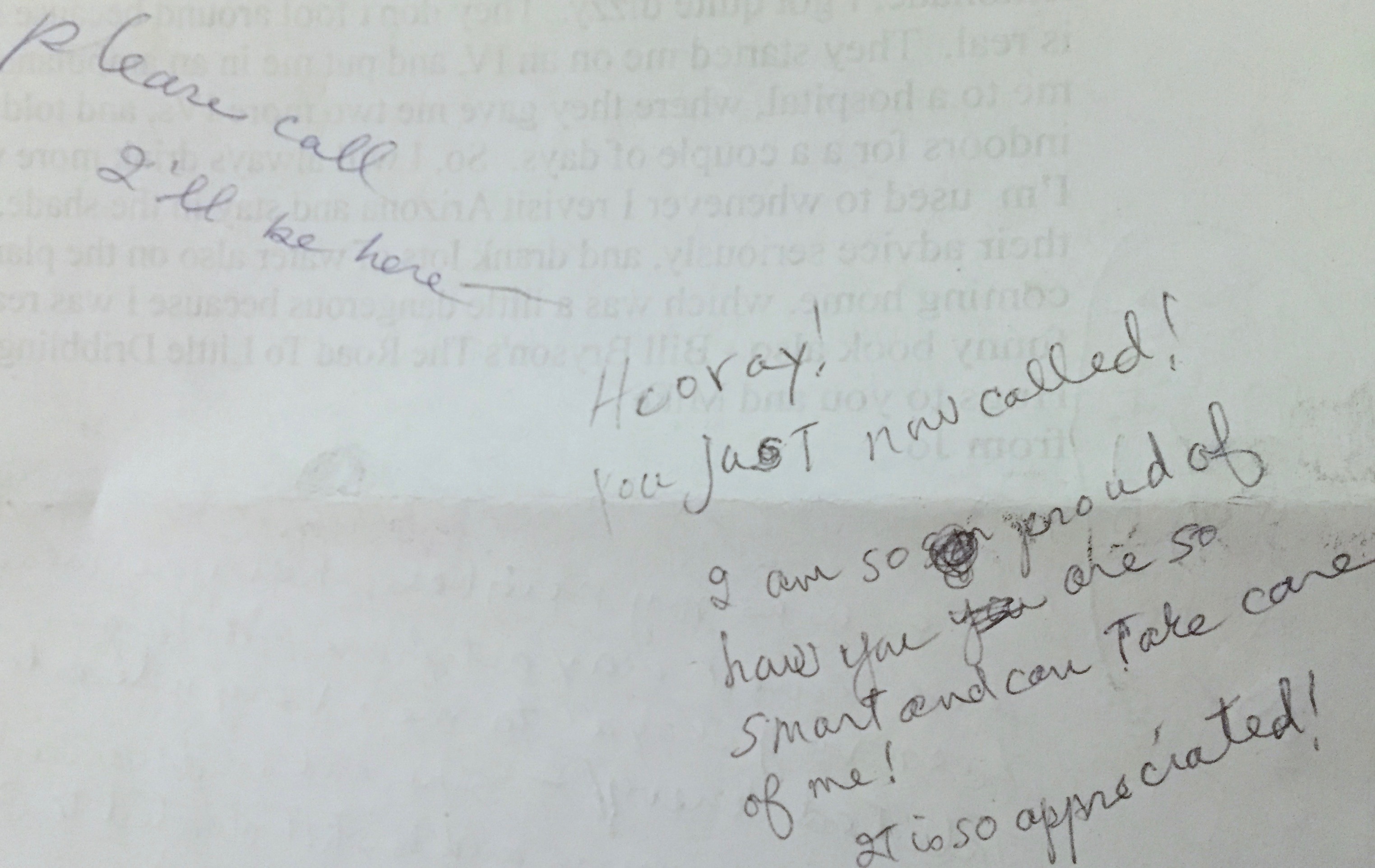
She often sent little hand-written notes to me in the mail on the back of newspaper clippings
and photocopies of magazine articles.
People dealing with dementia should know about the possibility of NPH, but it isn’t common, and isn’t a picnic to have the therapeutic brain surgery required to shunt off the fluid pressure that builds up in the brain because of it. NPH causes three cardinal signs that med students recite: wet, wobbly, wacky. More precisely: urinary incontinence, a rigid, “magnetic” walk, memory problems, and on imaging there are enlarged brain fluid spaces or ventricles suggesting the increase in CSF fluid pressure. NPH can easily be confused with untreatable dementia which is far more common and has similar symptoms.
Current diagnosis of NPH requires the 3-day lumbar puncture that my mom underwent, in a hospital, with incremental spinal fluid draining to see if relieving
pressure relieves symptoms. Her neurologist had done the procedure many times, and gave me hope. He was optimistic that she presented with the classic
signs of NPH. Each day that she had her CSF drained I would call her in the hospital to see if she was talking or feeling any better. By day three,
answer was a crushing no. All she got was the crushing headache that lumbar punctures infamously cause, and she was not walking or talking or thinking
any better. Her three-day experiment predicted that surgery to install a brain shunt to relieve some theoretical buildup of CSF would not resolve her
symptoms.
At least I had ruled that out as an option, I told myself. At least I tried. It felt good to know, and I had no
regrets about having her tested. I could not have lived with myself not knowing that she might have had something treatable. Out of options, all that
remained was to watch her disease progress. “Common things are common,” said my brother, who is an MD. I found his comment consoling. I’m grateful
for my PhD in drug design and synthesis, it helps to understand the problem. Otherwise I might still be in the frantic mode of trying to find something,
anything, that will stop the progression of her disease. The frantic diagnostic/treatment mode is not any fun. I’m sort of glad I’m done with the frantic fix it fix it fix it phase. The
fix it fix it fix it phase is both hopeful and horrible.

Her handwriting began to deteriorate. She can not write anymore.
Artist Kim Waters gave me the key understanding to my mom’s statement that she would be all around me. Tim and I cherish our years-long friendship with our former neighbor. Like so many, we are awed by her art. Her bearing is unusual; incredibly gentle, yet strong. With her long, golden hair and softly flowing, colorful attire, she has always given me the impression of some sort of otherworldly princess, living half-in our world and half-in another rarefied and mystical world that only her inner artist’s eye can see.

Kim Waters and her devotional art work. (Don't you immediately just love her?)
Kim used to live down the road from us, but moved to be take care of her own mother, in Washington, DC, where she lives and continues creating art. You may have seen her illustrations in Sally Fallon’s Nourishing Traditions cookbooks.
We often collaborated with Kim in printing her art. We have this gigantic art printer in our basement, mainly for Tim’s art and engineering projects.
You might imagine that possessing a jumbo printer is spectacular fun, but we have an ambivalent relationship with ours. It is actually a monster that
gorges itself on expensive ink even when we don’t use it and it tends to require even more expensive emergency resuscitation, unexpectedly, whenever
you most need to use it. Thus we like to give the monster in our basement a positive purpose, like printing Kim’s art. If you are interested in Kim’s art prints, let us know and we can work out a deal that benefits Kim and feeds our basement monster!
Kim was living in Washington DC and also visited us, a week prior to my mom's visit, to look in on her old property for sale down the street from us. We had Kim over to our house to chat with dinner and wine. The topic of The Purpose of Art came up, as it so often does with Kim and Tim, who are both artists. This is when Kim said something that riveted my attention.
She was discussing her Madonna and Child, in particular. She explained that her devotional artwork showed all the many possible forms of God, enabling
people to connect to one of the multiple aspects of the divine.
If you are uncomfortable with the word divine, substitute idealized. Both work!
“For example, here is divine child, the divine mother,” She said, referring to her painting. The gist of what she was saying was, all the things we
find divine about a child, we can contemplate. Art forms a bridge to that Divine Baby concept.
All the things we find divine about a mother, we can contemplate, again, with art being a bridge to that concept, she added.
“But then there are other forms of the divine in art”, she continued. “There is the Divine Friend. The Divine Sister. The Divine Brother. The Divine Father. The Divine Lover. The Divine Teacher. The Divine Healer—”
Tim interrupted, “How about the divine (explictive, meaning jerk)—”
“Shush!” I silenced him. Kim's thread was tickling something powerful inside of me, and I didn't want it to get railroaded off into his crass form of a joke. “I want to hear this!”
I recognized that Kim was talking about archetypal figures, which I was familiar with from my mother’s mother’s teachings on Jung and symbolism. Archetypes are powerful symbolic figures that repeat themselves in literature, like the Wise Old Man, or the Fool on a Quest, or the Trickster.
“Symbols are the bridge to the subconscious”, grandma Neva would say to me. I knew that already, but this felt like a new twist. Multiple divine, or, if you like, idealized, forms of human experience, from baby to elder, and everything in between, could be expressed symbolically and contemplated. I found the Kim’s description comforting. This was the seed that sat in me for a few years.
Here is how the seed sprouted. I’m an obsessive diary-writer, I have written every day, if I can, for years now. It really helps sort
out my thoughts and feelings and I dearly hope that all my writings will all be preserved for future generations of my family. This excerpt might help
communicate how my thinking about her “being all around me” transformed.
Oct 5, 2017
I don't like to think that I am one of the last containers of her words. It is too much responsibility to hold another person, to preserve them, in your mind. Too much, too much. So many little things remind me of mom.
Her mom used to say “there are no special relationships.” Something from her ACIM (A course in Miracles.) I always resisted that doctrine reflexively, yet knew she was right on some level. Physics shows we can’t cling to any particular notion of an individual persisting. All things die. Duh. Our actions are our only belongings.
Last night I was telling Tim, after we watched another episode of Doc Martin, which is full of funny British slang, innit! How yes, indeed, Tim was right, they have far more colorful language than Americans, more playful, and I always admired that about the culture, perhaps my admiration is genetic, as most of our ancestry is English and British Isles.
Tim is such a good listener. It helps. I rambled on, told him how I remembered my mom reading to me so many British children's books, how I remember her explanation that they have a more playful way with language. I remember her telling me, for example, instead of saying "I will go up the stairs" they will say "going up the apples and pears" because it rhymes.
I admired how she knew these things. She was once very literary, and so proud of her parents who were literature professors. That is just one of so many memories of my mom that I cherish. How can I hold on to all these bits of information? All this meaning will dissipate entropically, into so much heat and wiggling particles, random noise in the universe. It is not possible to hold on to it all. This particular memory will eventually die. It’s died in her, certainly! She doesn’t even know my name now. I am the only one holding the “apples and pears” explanation she gave following our reading of some book together. That hurts for some reason.
I have been comforted lately by the idea that the idea of my mother is not completely encapsulated by the person I think of as being my mother. Rather, the idea of my mother—an ideal mother—is more universal and persists. Motherly-ness is a concept that has held strength on Earth for millennia.
Think of all the animal mothers, birds mothers and dinosaur mothers and mammal mothers and our ancient hominid ancestor mothers, the unknown mothers, my unknown European colonial mothers sailing to Massachusetts long before the Revolution, and my pioneer ancestor mothers treking with their children across the Midwest—all their unseen energy, their strength, their power! If it were not for them, I would not be here. Maybe part of them lives in me.
I see people being motherly all around me. They are not all female, and they can be any age, old or young. In friends and family and neighbors and strangers. This Motherly-ness is apparently a force on Earth that is persistent in nature. Life could not persist without it. I have to think about this more. It is, indeed, a force that is all around me if I look for it.
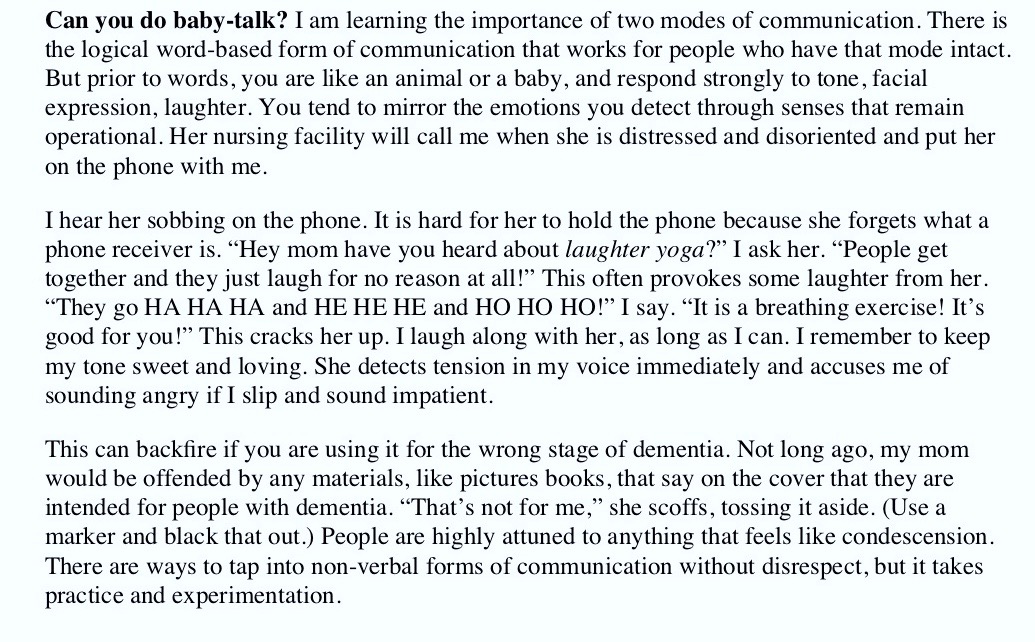
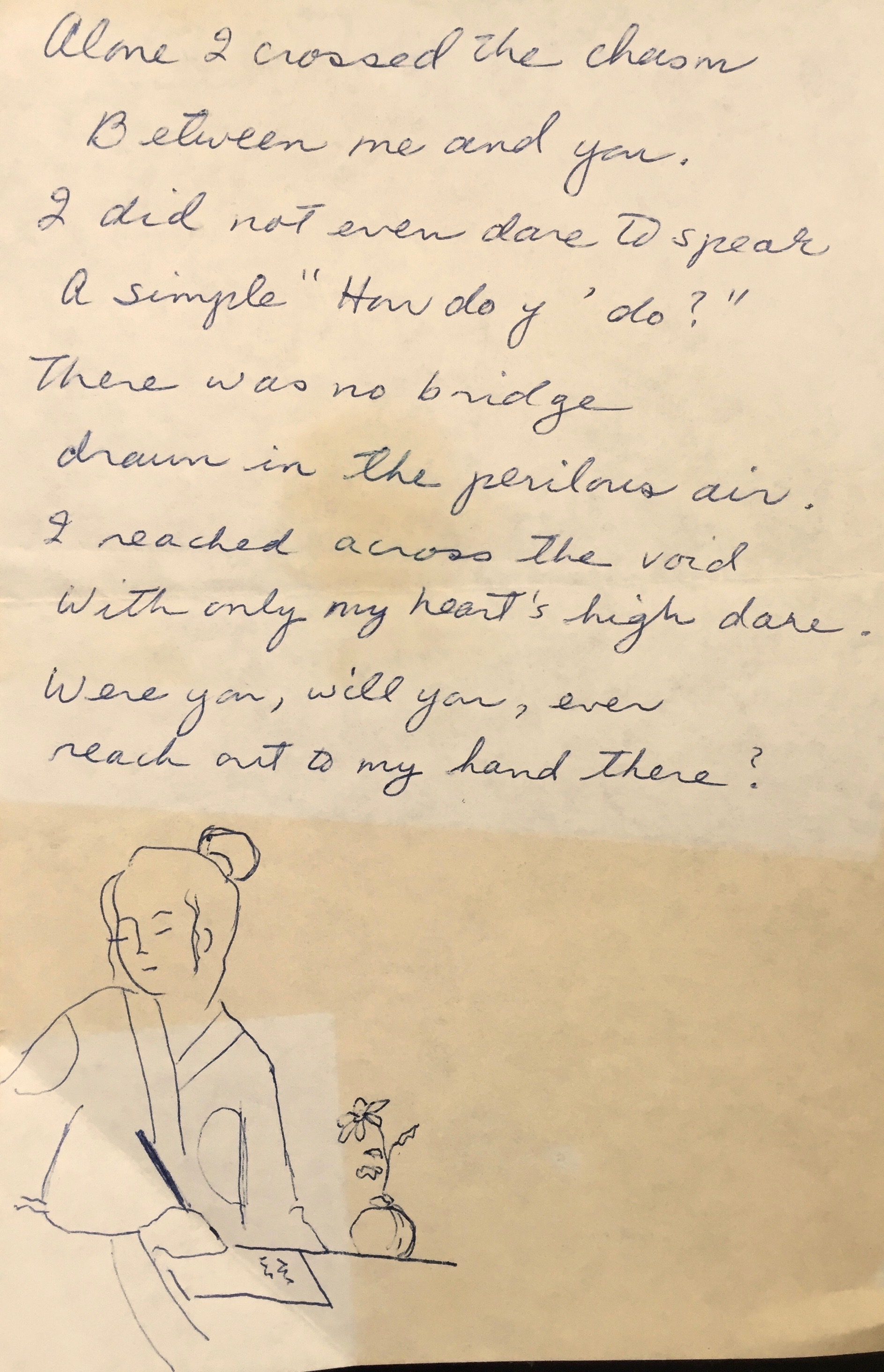
I stumbled across this in sorting out my mom's possessions:poetry in my mother's handwriting,
(I don't know if it is hers,) plus her classic doodling.
Mom and I had always been best buddies. She had language and memory problems, as well as crying spells, most of her adult life, which our family used to roll our eyes over and make fun of, not understanding that we were actually witnessing symptoms. Now I see how well her early-onset dementia was masked by her cognitive reserve; she was well-educated and well-read.
A few years ago, mom and I were emailing each other regularly, sharing book recommendations. Emailing! I can hardly believe it when I run across her old emails to me. Now 80, she can no longer read or write. She thinks she can, and whenever I tell her I’m writing an article she demands that I send it to her. (I’m told she still has old articles I wrote a few years ago but she hasn’t managed to read them.) She can not figure out how to make phone calls, but she can have someone hand her a phone when we call her nursing home. She doesn’t understand her disablement, and tells me repeatedly that there is nothing wrong with her and she feels just fine! She can not remember my name.
It doesn’t hurt that she doesn’t remember me. It’s mostly my name she doesn’t remember, but she also asks where I live, what I do. She was astonished to learn I was a chemistry professor. I am surprised that this does not hurt at all. I had expected this, and thought that it would hurt, but the first time it happened, it did not hurt. I suppose it only hurts if you expect the person they were to persist. I don’t expect that.
Our current relationship. As medical and financial power of attorney, I manage all her finances and medical care long-distance. If you are ever given the opportunity to become a POA, think first very hard about how much time you have to devote to what is very much a part time job.
Don’t feel too sorry for me. A lot of well-meaning people want to rush in to tell me how sorry they are that I am in the burdensome role of being a caregiver. I’m grateful, but want to reassure everyone. It can be terribly hard and don’t want to make light of it. The worst part, honestly, is completely FREAKING out a couple times a year over whether Medicaid and Medicare can cover literally thousands of dollars of care every month! (So far, so good. And if anyone takes that away from us, I will be out there with the rest of America carrying my pitchfork and torch and rioting. She has no money and her care costs thousands of dollars a month.) I can only speak for myself, but most of the time, given the circumstances, I enjoy being a caregiver.
That sounds wrong. I don’t enjoy what is happening to my mom. What I mean to say is that it is going as well as it can, considering this is a progressive disease with no current cure.
It isn’t all terrible! I feel proud when things are going smoothly. It feels like a privilege to be able to care for someone, even though it consumes a huge amount of my time and emotion and money. (Like spending an hour on Amazon this morning reading reviews on pricey one-button radios for people with dementia, and then another half-hour correcting items on her current meds list with her primary and making sure insurance pays for them, and then making sure her credit is still frozen with the credit bureaus.) I’m learning a lot that is valuable to me practically and emotionally.
Try regular compassion meditation: Brain imaging research shows caregiving burnout can be reduced by focusing on compassion rather than empathic suffering. I really do use this tool, setting a timer and sitting, and it helps me keep from spiraling down.
All I ask is that the person who is now my mom is happy, and for the most part, I and several other people I work with long distance labor to make that happen. I couldn’t ask for more.
She is not the same person, she is another person. I have lost who she was, and maintain the health and well-being of the person she is, now. Many people say that dementia creates two people: the person you lose, who you grieve, and the person who remains, who needs care. This is absolutely true.
Our conversations continue. Almost every day, we talk long-distance after a nurse hands her the community phone, making sure she is holding it next to her ear. Our conversations are goofy. With goofy syntax and goofy wording, we talk in circles, repeating the same ideas over and over. I strap my phone to my head with a headband and do chores around my house while we talk.
Sometimes the conversations are “jolly”, to use one of her favorite adjectives. Sometimes they are not jolly, and she perseverates. Perseveration can occur in mental illness and brain injury. Ironically, it was my mother who first taught me the word perseveration in regard to her sister, who was schizophrenic. Aunt Sharon was a gentle soul, but would sometimes perseverate about little things and hold grudges for some slight she had imagined, like someone suggesting she remove a price tag from some clothes she was wearing. She hated to remove price tags from her clothes, and she hated being told what to do.
With perseveration, someone gets stuck in a mental loop, asking or demanding the same thing over and over, or simply saying the same word over and over. It is like a form of obsessive compulsive disorder. It’s exhausting. Lately my mom demands to know why she can’t move back into her old home, and there is no logic that can persuade her she needs to stay where she is in the nursing home. She keeps trying to pack, churning her tiny nursing home room into chaos.
“I feels fine!” she tells me. “And what is my name?” I ask gently. “Oh, well, I don’t know that because you are so far away,” she says dismissively. It’s amazing to me that she doesn’t understand that something is wrong with her. She gets angry or cries when I tell her she can’t move back to her old home. I am learning to sidestep her demands to move and change the topic.
This was one of our recent conversations:
“Do you know where I am? How did you know I am here?” She asks me incredulously, every single time I call.
Because I PUT you in that nursing home, I think. “Oh, I talk to everyone around you, every day, to make sure you are okay,” I say vaguely.
“You do?”
“Oh yes, every day.”
“I don’t know what I am doing here!” she says.
“It’s a healing place,” I say. “Everyone around you cares for you.”
“Yes, I think I can see that,” she says haltingly.
“I’m going to call you every day to see how you are,” I say. I say this every time I call her.
She cries with joy, and says, “Oh, I just love when you call!” On the most recent conversation she cracked me up by ending the call stuttering, “You…you
have an AD…AD…ADVANCED BRAIN!”
“I do?” I said, laughing.
“YES! And…I think you got it from me!”
Misconceptions about Alzheimer’s and testing, and current thinking on preventing dementia (optional reading)
Some tests, like the one we used to rule out NPH, give peace of mind, and others are not helpful, and it all depends on the person. We are still not certain that my mom has Alzheimer’s. People wrongly use the terms Alzheimer’s and dementia interchangeably. A lot of people don’t know that you can’t really diagnose Alzheimer’s dementia without a brain autopsy after death, or possibly a several-thousand dollar PET scan. Both could show the characteristic amyloid buildup in the brain in Alzheimer’s. But some people have amyloid build-up in their brain and don’t have dementia! And some people have more than one kind of dementia taking place at the same time!
Thus the PET scan is not conclusive. Because my brother and I knew this, we opted out of giving our mom the expensive scan. It helps, if you are considering a test, to cooly ask yourself, and then what? What would you do differently if you learned something? If the answer is “nothing,” then maybe the test is pointless. Sometimes it helps to rule things out, though, for peace of mind, as in the case of testing my mom for NPH.
So all you can say for certain about profound cognitive decline is that it is some form of dementia, and since Alzheimer’s is so common, it is statistically likely to be that. There are other types of dementia, for example, vascular, Lewy Body, Parkinson's, and frontotemporal or FTD. Each features irreversible buildup of toxic proteins in the brain and slightly different symptoms. (If you want to do some good after your loved one passes away, a great research resource to donate to, for people who don't have Alzheimer's, is the Harvard Brain Bank. I've signed my mom up for that but I think she might be disqualified because I can't really tell for sure whether she has FTD or primary progressive aphasia or the more common Alzheimer's.)
Progressive dementia is incredibly common. Researchers now think the process begins ten or even twenty years prior to symptoms expressing themselves! The current speculation is that this timing is why it is so hard to find a treatment, and currently there are none. Drugs that increase brain neurotransmitters (ie, memantine, donepezil) only barely marginally slow memory loss to a point. They are not cures.
I was even assured by a well-meaning but ignorant hand-waving friend, who said, “Oh, they have medications for dementia, don’t worry.” Yes there are meds, but they barely help and they are not cures.
The best medication for my mom, which may not be appropriate for everyone, was our discovery of something called Nuedexta, which limited her daily
crying spells. It's often used for people with traumatic brain injury related mood disorders. She's got brain injury, it just happens to be internally,
rather than externally, generated.
It’s the weirdest medication! It’s made from an old cough medication (dextromethorphan) plus another molecule that alters how this metabolized. My brother the doctor joked, “at least mom won’t get a cough!” upon her neurologist’s recommendation for its prescription. But Nuedexta has been a miracle for us in limiting her crying spells. I now understand her decades-long, annoying and regular crying spells and temper tantrums were a consequence of her brain injury. That gives me a sense of relief, to understand the mechanism. The part of her brain that regulates emotion and says, “maybe you shouldn’t break down crying or screaming just now” was not working. (I have no conflicts of interest to disclose, which means I get absolutely no money from anyone. Sad, really.)
I pity the families who are traveling along this weedy highway without the infrastructure of a firm medical background. I mean, it took a few years for my brother, an MD, and I, with the background as a research scientist, to figure out what the correct current procedure was just to diagnose and rule out NPH! You have to ask a lot of questions and stay skeptical. For the first couple years Joe and I were going down the wrong track and bullying various poor neurologists to get our mom some other procedure using nuclear scintography before we learned about the now standard three-day lumbar drain. If it's hard for us to figure out what to do...!
It doesn’t help that people who don’t know the difference between their elbows and their astrocytes are practically invited to disseminate their well-meaning advice to anyone on the internet stupid enough to click and scroll. In fact just today I got a random comment on my column from a stranger: “Carbon60 prabhaus woerks wanders fr deamentia!” I consider a snarky response: The only thing we can say for certain is that your recommendation does not improve atrocious spelling errors. I hesitate to unload my angry retort. I simply delete the comment from my blog. Better. It’s not a good policy to feed my inner snark.
Researchers are suggesting that by the time new interventions are tried in clinical trials, the decades-long process of buildup of misfolded protein in the brain has become irreversible, explaining why hundreds of drugs (such as injectable monoclonal antibodies targeting amyloid or tau) have currently failed for treating Alzheimer's. I think there will be a treatment someday. We just don’t have it yet.
How not to get dementia
All the original research reports I read tell me that the early-onset dementia my mom has, which showed its signs with her struggling with speech in
her 40’s and 50’s, is more likely to have genetic components than the more common late-onset dementia, which presents in the 70’s and 80’s. That being
said, if you have a parent with dementia, don’t freak out too much about inheriting it. Most cases of dementia are not genetic but sporadic,
random.
Many people with genetic risks for dementia never get dementia. Lots of people who don’t have genetic risks still get dementia. (My mom does not have the Alzheimer's risk-associated APOE4 alleles, for example, yet she still got dementia. Lots of people with APOE4 don't get Alzheimer's,
too.)
It is all a matter of many risks tipping the balance. Lifestyle makes a big difference. My mom always struggled with her weight, and poor
blood sugar regulation and diabetes are known to increase the risk of dementia. She took prescription sleep aids and anticholinergic medications for
years, which are also tentatively associated with dementia risk in some large meta-analyses and observational studies. I think her prescription use
didn’t help. I labored to get her off prescription and over the counter sleep aids. She sleeps much better now, just using melatonin.
The best protection against dementia, by far, hands down, is regular physical exercise, according to the research that I read. There are thousands of studies backing this up, but here's just a bit of factual inspiration if you need it: Exercise boosts BDNF, or brain derived neurotrophic factor, which stimulates the birth of new brain cells in a couple regions, strengthens the connections between nerve cells, and helps preserve neurons. Also, people who exercised for a year enjoyed an increase in their hippocampal volume (that's a region of the brain associated with memory) of 2% while people who did not exercise for a year suffered a decrease in volume. That’s the number one reason why I exercise my butt off for at least half an hour every morning. It’s partly motivated by fear! Actually, I enjoy it a great deal. It feels selfish. I listen to audiobooks and podcasts and try to make it a mental workout as well.
I wrote a big book on supplements and like to keep up with research but I have yet to find anything that will do anything magical. At best, there are supplements I place in the category of “might help a little and can’t hurt,” like turmeric. (I’ve my mom on turmeric for years, and guess what, she still has dementia!) You might want to ask your primary to be sure you get enough B12 and magnesium because deficiencies of these are more common and can sometimes affect cognition. Rather than focusing on supplements, you are better off just eating less processed food and more plants.
Research also suggests cognitive reserve—your brain muscle, so to speak—buffers against dementia for some time. Rather than buying expensive brain-boosting software, however, I’d invest in more useful tools, like learning music or another language, and better yet, something with a social component. A strong, non-digital social network is a powerful protective factor.
A high cognitive reserve is good, but can actually hide an ongoing neurodegenerative process. A flexible, plastic brain nimbly finds work-arounds to mental roadblocks. Typically when the cognitive reserve “buffer” wears out, dementia appears, accelerating rapidly. This sudden mental decline is what we are seeing with my mom, and also with Tim’s dad, who was a PhD nuclear physicist and longtime Buddhist meditator. He had an impressive cognitive reserve, too.
All dementias feature misfolded protein build up in the brain and we now know that natural, unmedicated sleep is essential to remove this toxic junk from the brain. Dementia is usually associated with insomnia. There is a reason for that. Use eye-blinders or light-blocking curtains to make sure your sleeping room is as dark as possible. Don't drink alcohol if you think it interferes with your sleep; typically the problem manifests in waking you in the middle of the night and this interferes with the natural sleep process. I call this wine-somnia. I enjoy a little wine on special occasions with dinner and friends, but I like deep, deep, wonderful healing sleep so much more.
So the best thing we can do, while waiting for a cure that might never come, is to adopt healthy lifestyles. Exercise daily, sleep soundly
(this means without prescription or OTC sleep medication), socialize face-to-face, don’t eat processed foods, eat lots of plants.
News+Blogs Categories
Archive

